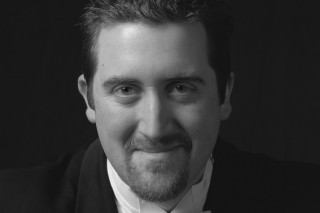Column Name
Title
Subhead

Kenneth Bryson
Kenneth Bryson (M.M. ’04, voice) is a singer and voice teacher based in Basking Ridge, N.J. His experience learning how to work with a student with dyslexia prompted him to write ![]() "Teaching a Student With Dyslexia," which appeared in the Journal of Singing, which is published by the National Association of Teachers of Singing (NATS).
"Teaching a Student With Dyslexia," which appeared in the Journal of Singing, which is published by the National Association of Teachers of Singing (NATS).
Body
When you’re a teacher, from time to time you’ll run across a student whose patterns of learning stop you in your tracks and force you to analyze your tried-and-true teaching methods. I had an experience like this about five years ago, when a student’s mother contacted me to ask about my private voice studio. The inquiry wasn’t anything out of the ordinary until she explained to me that her daughter faced severe dyslexia and asked if I would be comfortable teaching her.
Agreeing to teach that first student with dyslexia led to an incredibly enlightening and rewarding experience for both of us. Candidly, our work together involved a fair share of trial and error on both of our parts, but eventually we found several methods that really worked.
A major challenge I encountered was in my research on how to teach this young woman. Of the research conducted on how individuals with dyslexia learn, very little concerns dyslexic musicians, and even less addresses singers. Through much conversation with my student and experimentation during her lessons, I developed several teaching methods that worked for her—and, later, for other students with dyslexia.
One of my most important discoveries was that dyslexia does not fit nicely into a box. It affects students in different ways and to different degrees, and their challenges are as unique as they are. It’s fairly common knowledge that dyslexia can affect a person’s reading ability and comprehension, but what many unaffected people don’t know (or haven’t thought about) is that it can also present challenges related to music, such as notation, sight-reading, deciphering rhythm, memorizing melodic and rhythmic repetition, and maintaining a steady beat. When the dyslexic musician is studying voice, his or her challenges also include the processing of lyrics, especially ones in a foreign language.
Some students with dyslexia will have very few issues when it comes to processing music, while others face more significant hurdles. One of the things I found through research and trial and error is that multisensory learning, which involves the simultaneous use of visual, auditory, and kinesthetic-tactile pathways, is most effective in addressing these challenges.
An example of a multisensory method I use in my studio both with that original student and with subsequent ones is making an audio recording of each lesson for the student to review at home (repeatedly) while studying the music on the page. It helps the singer to learn the melody as well as the accompaniment. Another useful tool is a version of Margaret Hubicki’s colored staff, as note recognition and recollection can often present a major challenge for students with dyslexia. Many dyslexic musicians struggle with the juxtaposition of black ink on white paper. For them, the black notes can appear to “float” around the page and can strain the eyes. This sensitivity is called the Irlen Syndrome or scotopic sensitivity syndrome. The use of a specific color for each line and space is easier for an affected student to read and process, and it consistently helps build and solidify note recognition.
It’s easy to focus on the negative aspects of dyslexia and how it affects musicians, but the positive effect music can have on people with dyslexia is rather astounding. Musical training can help with the development of literacy skills and increase auditory sensitivity, which can in turn prevent speech and language challenges.
Since the publication of my Journal of Singing article, the outpouring of responses I’ve received from members of the vocal pedagogy community has been great. Several individuals have contacted me simply to extend their thanks for writing an article on dyslexia, a disorder that affects so many and is not well understood. I was very flattered when one person contacted me about citing my paper in a presentation. However the best response came from a colleague who teaches at a university and had a student in his studio who was on the verge of failing because he couldn’t fulfill his singing and other musical requirements. After several conversations, this teacher decided to experiment with multisensory methods in this student’s lessons. Months later, the teacher let me know that the student had passed his end-of-year jury with flying colors—for the first time ever.
It’s pretty astounding to think that all of this is the result of one student’s interest in private vocal instruction and her mother’s decision to share the tiny piece of information that she had dyslexia. It highlights the need for voice students to speak openly with their teachers about any learning challenges they may face.




